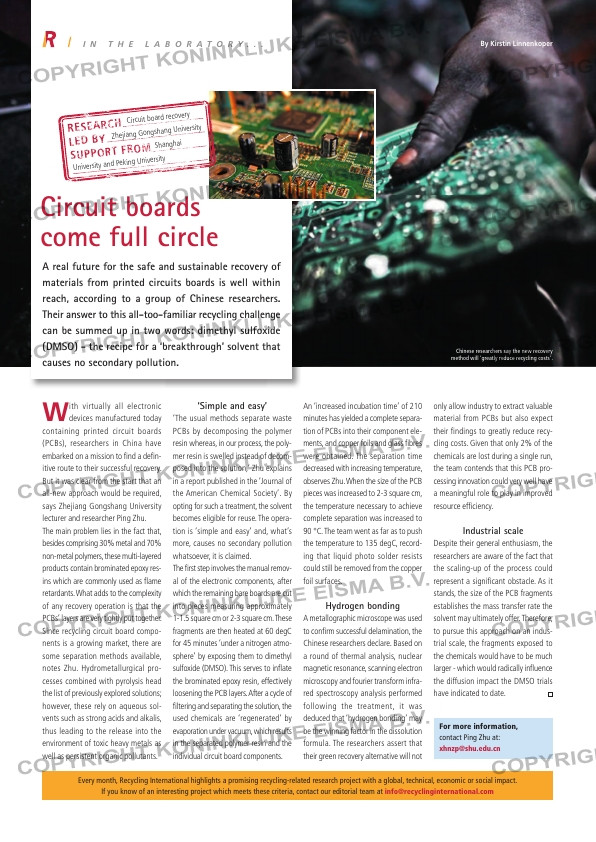Page 49 from: April 2013

I N T H E L A B O R A T O R Y . . .
only allow industry to extract valuable
material from PCBs but also expect
their fi ndings to greatly reduce recy-
cling costs. Given that only 2% of the
chemicals are lost during a single run,
the team contends that this PCB pro-
cessing innovation could very well have
a meaningful role to play in improved
resource effi ciency.
Industrial scale
Despite their general enthusiasm, the
researchers are aware of the fact that
the scaling-up of the process could
represent a signifi cant obstacle. As it
stands, the size of the PCB fragments
establishes the mass transfer rate the
solvent may ultimately offer. Therefore,
to pursue this approach on an indus-
trial scale, the fragments exposed to
the chemicals would have to be much
larger – which would radically infl uence
the diffusion impact the DMSO trials
have indicated to date.
With virtually all electronic devices manufactured today
containing printed circuit boards
(PCBs), researchers in China have
embarked on a mission to fi nd a defi n-
itive route to their successful recovery.
But it was clear from the start that an
all-new approach would be required,
says Zhejiang Gongshang University
lecturer and researcher Ping Zhu.
The main problem lies in the fact that,
besides comprising 30% metal and 70%
non-metal polymers, these multi-layered
products contain brominated epoxy res-
ins which are commonly used as fl ame
retardants. What adds to the complexity
of any recovery operation is that the
PCBs’ layers are very tightly put together.
Since recycling circuit board compo-
nents is a growing market, there are
some separation methods available,
notes Zhu. Hydrometallurgical pro-
cesses combined with pyrolysis head
the list of previously explored solutions;
however, these rely on aqueous sol-
vents such as strong acids and alkalis,
thus leading to the release into the
environment of toxic heavy metals as
well as persistent organic pollutants.
An ‘increased incubation time’ of 210
minutes has yielded a complete separa-
tion of PCBs into their component ele-
ments, and copper foils and glass fi bres
were obtained. The separation time
decreased with increasing temperature,
observes Zhu. When the size of the PCB
pieces was increased to 2-3 square cm,
the temperature necessary to achieve
complete separation was increased to
90 °C. The team went as far as to push
the temperature to 135 degC, record-
ing that liquid photo solder resists
could still be removed from the copper
foil surfaces.
Hydrogen bonding
A metallographic microscope was used
to confi rm successful delamination, the
Chinese researchers declare. Based on
a round of thermal analysis, nuclear
magnetic resonance, scanning electron
microscopy and fourier transform infra-
red spectroscopy analysis performed
following the treatment, it was
deduced that ‘hydrogen bonding’ may
be the winning factor in the dissolution
formula. The researchers assert that
their green recovery alternative will not
‘Simple and easy’
‘The usual methods separate waste
PCBs by decomposing the polymer
resin whereas, in our process, the poly-
mer resin is swelled instead of decom-
posed into the solution,’ Zhu explains
in a report published in the ‘Journal of
the American Chemical Society’. By
opting for such a treatment, the solvent
becomes eligible for reuse. The opera-
tion is ‘simple and easy’ and, what’s
more, causes no secondary pollution
whatsoever, it is claimed.
The fi rst step involves the manual remov-
al of the electronic components, after
which the remaining bare boards are cut
into pieces measuring approximately
1-1.5 square cm or 2-3 square cm. These
fragments are then heated at 60 degC
for 45 minutes ‘under a nitrogen atmo-
sphere’ by exposing them to dimethyl
sulfoxide (DMSO). This serves to infl ate
the brominated epoxy resin, effectively
loosening the PCB layers. After a cycle of
fi ltering and separating the solution, the
used chemicals are ‘regenerated’ by
evaporation under vacuum, which results
in the separated polymer resin and the
individual circuit board components.
Circuit boards
come full circle
A real future for the safe and sustainable recovery of
materials from printed circuits boards is well within
reach, according to a group of Chinese researchers.
Their answer to this all-too-familiar recycling challenge
can be summed up in two words: dimethyl sulfoxide
(DMSO) – the recipe for a ‘breakthrough’ solvent that
causes no secondary pollution.
By Kirstin Linnenkoper
Every month, Recycling International highlights a promising recycling-related research project with a global, technical, economic or social impact.
If you know of an interesting project which meets these criteria, contact our editorial team at [email protected]
For more information,
contact Ping Zhu at:
[email protected]
RESEARCH
LED BY
SUPPORT FR
OM
Circuit board r
ecovery
Zhejiang Gong
shang Univers
ity
University and
Peking Univer
sity
Shanghai
Chinese researchers say the new recovery
method will ‘greatly reduce recycling costs’.
RI-3_In the laboratory.indd 49 08-04-13 13:27



